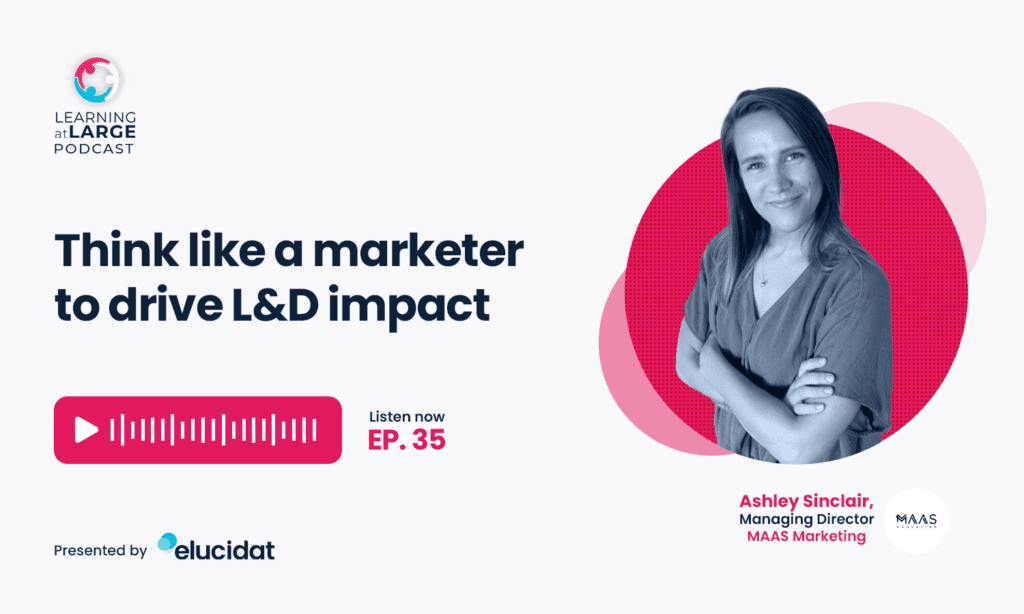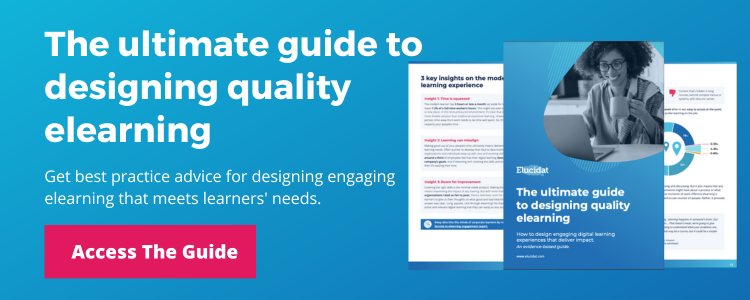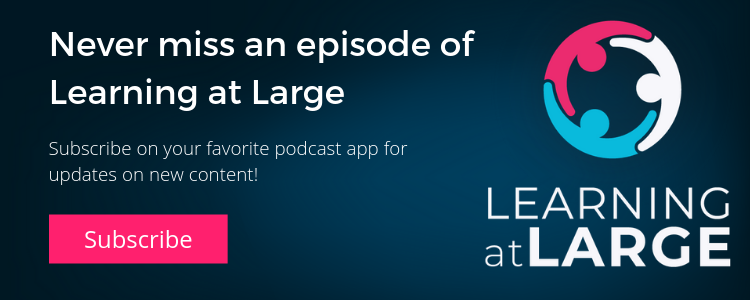Think Like A Marketer: Ashley Sinclair
From work deadlines to pressures at home, lots of things are vying for your employees’ attention. If learning is going to be effective, you need to grab their interest and keep it. Hear how Ashley Sinclair, Managing Director at MAAS Marketing, uses marketing techniques to deliver this impact. Find out why focusing on human beings rather than learners is essential, and explore how quick experiments and small changes will help you find out what works.

Top tips for applying marketing thinking in L&D
Don’t have time to listen now? Here are some top tips from Ashley:
- Drive awareness and start building learning habits: Don’t just provide content and hope people will learn. Use marketing techniques to create awareness and engagement.
- Think of human beings, not one-dimensional learners: Effective L&D is people-centered. Get a full understanding of your audience before you decide how to target them.
- Experiment, learn, grow: It takes a long time to see the effect of training programs. Don’t wait. Try things out. Find out what works and what doesn’t. Adapt your approach.
- Start small and see the impact: Don’t get overwhelmed with marketing theory. Make small changes to quickly see the impact of marketing thinking.
1. Drive awareness and start building learning habits
With so much transformational tech and training content available, there’s no shortage of opportunities for employees to learn. But simply providing platforms and online learning won’t get people engaged. If you don’t want to see your L&D investment wasted, you need to think like a marketer.
For Ashley, two key marketing elements are often missed in L&D: creating awareness and building habits. You can’t just tell people to go and learn. You need to sell it to them. People need to understand the benefits before they’ll take action. Then, once they’re accessing your learning content, you need to keep them coming back.
“There’s a lot of proactive, iterative thinking that exists in the world of marketing that could be very much applied to learning. Ultimately, we’re trying to do the same thing. We’re trying to get people to do things they don’t want to do. And know about things they don’t know about yet.”
2. Think of human beings, not one dimensional learners
Every organization contains a huge variety of people. They have different behaviors, preferences and pain points. If you’re going to engage them, you need to stop thinking of a one-dimensional learner. Start thinking of fully formed human beings.
Ashley says learning is only effective if it’s grounded in what people need. You have to get into the brains of the people you’re trying to target. Speak to people. Find out what they really want. Create personas. Discover what triggers their emotions and motivates them. Feed this understanding into your work.
“Learning is very unlikely to ever be a priority for the majority of your human beings at work. And that’s okay. It’s our job to persuade and influence them to prioritize that further. People have wants and needs and desires that extend way beyond the organization. They’ve got pressures at home. They’ve got children. They’ve got animals. They’ve got so much juggling all the time. We need to kind of create a more well-rounded view of these individuals in the workplace.”
3. Experiment, learn, grow
Whether you’re understanding a learning need or launching your solution, experimentation is the key to success. In Ashley’s experience, the business often comes to L&D asking for training and it’s created. There’s little interrogation of the business need or the best solution.
Rather than designing, creating and launching a training program and waiting to see the impact, start experimenting. Explore different solutions in the learning and marketing space. Try things out without worrying about failure. Find out what works and what doesn’t. Learn and adapt your approach.
“Trying new things, testing and learning. I think failing is one of my favorite aspects of marketing. It’s something I’d love to see L&D be okay with…I would just love to see us having a little bit more gumption and pushing back or trying some things. I’m a big fan of ‘do it and apologize later’. We can’t make the changes that need to happen for our learners to have impact without doing that.”
4. Start small and see the impact
From content strategy to learning campaigns, there are a lot of marketing approaches you could explore. So where do you start? Don’t get overwhelmed trying to apply marketing thinking to everything you do. Ashley recommends starting small.
Pick one area where you can easily make a change and quickly see your impact. Improve the copywriting of your course descriptions and see whether your click through rate changes. Try out different email subject lines and assess how people respond. Create a user generated social marketing campaign and see if awareness increases.
“Try some stuff. Do a pilot. Do something smaller. Focus on an area where you have an engaged audience already, and try a few little tweaks…You know, that doesn’t have to be a big marketing strategy, but that’s employing marketing tactics and applying them to your learning function.”
A quick recap
Ashley is passionate that marketing thinking is the key to delivering impact in L&D. She has four strategies to start thinking like a marketer. Don’t just launch more learning, drive awareness and engagement. Get into the brains of the human beings you are targeting. Experiment with different marketing techniques to identify what works. Start with small changes so you can quickly see your impact.
Want to find out more? Check out the full podcast above.
About Ashley
Ashley combines years of marketing experience with a deep-rooted knowledge of the world of learning. She founded MAAS Marketing in 2019 to help businesses use marketing thinking to drive impact in L&D.
You can find out more and get connected with Ashley on LinkedIn.
On Ashley’s reading list
Find out which books help Ashley create impact in marketing and L&D.
The Science of Storytelling, Will Storr
Stories are an essential part of what makes us human. This book can help you use storytelling to get people engaged and drive them to action.
Atomic Habits: An Easy and Proven Way to Build Good Habits and Break Bad Ones, James Clear
How can you keep people engaged in learning? James Clear explores how minuscule changes can grow into life-altering habits.
Permission Marketing: Turning Strangers into Friends and Friends into Customers, Seth Goddin
Employees are bombarded by marketing messages from almost every direction. In this book, you’ll find out how you can get permission to grab their attention.
Looking for more reading tips? Check out our book blog.
Join the conversation!
We’d love to hear your thoughts on our podcast, so feel free to get in touch with our podcast host, at kirstie.greany@elucidat.com. As always, don’t forget to subscribe to Learning at Large in your favorite podcast app and leave us a 5-star rating if you enjoyed it. Thank you for joining us, and see you next time.

